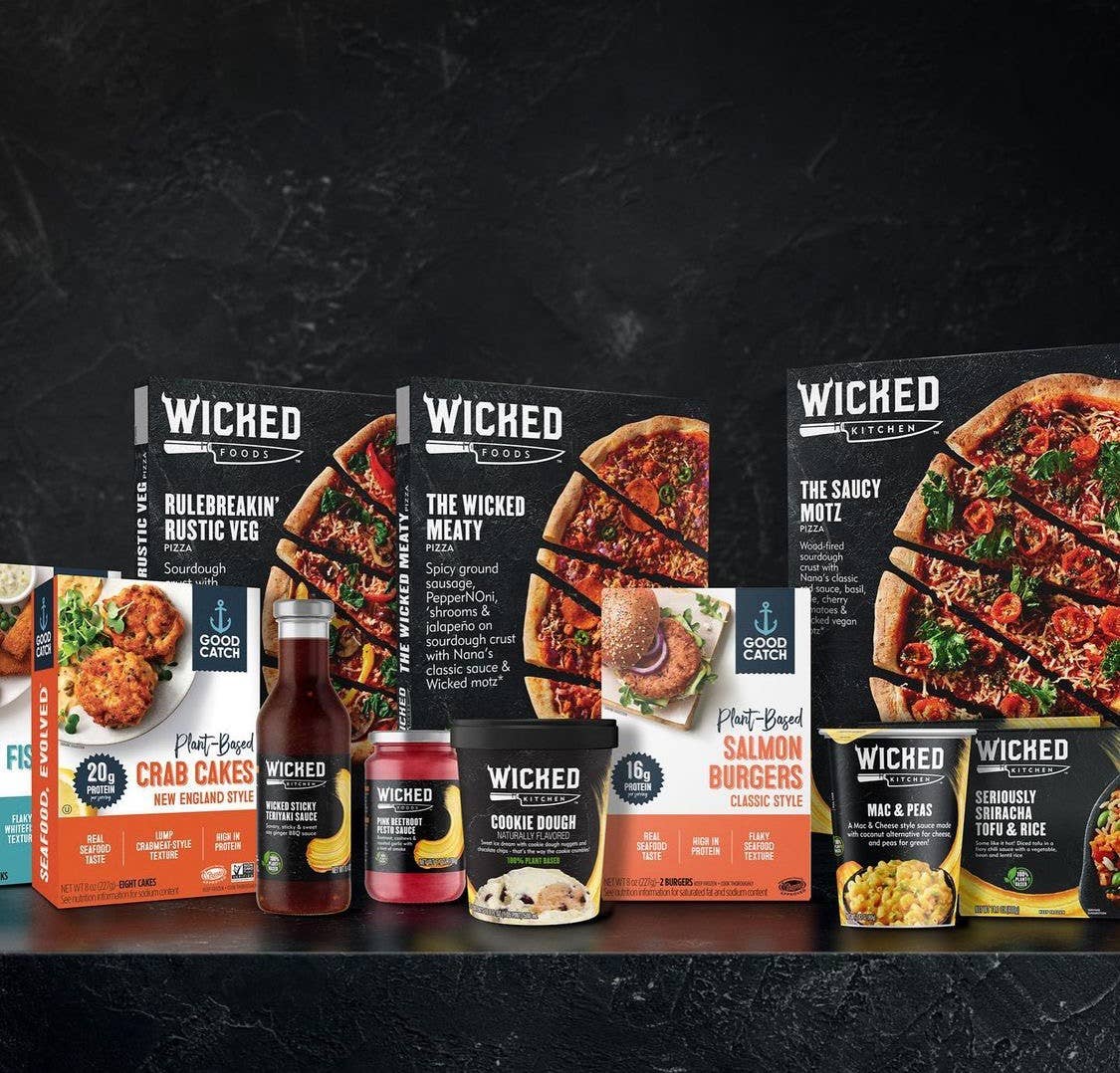
Sales of Plant-Based Food Have Grown 54% to $7.4 Billion Since 2018
The plant-based food market continues to grow and has outpaced sales of other food categories in recent years. The Good Food Institute (GFI) released a report that sales of plant-based food hit $7.4 billion this year, growing by 54 percent since 2018 while the total food market only increased sales by 2 percent over the same period.
The continued growth of the plant-based food market put to rest any worry that this area is experiencing a slowdown post-pandemic or that the demand for meat alternatives and dairy-free milk, cheese, and creamers was a fad. In contrast, general food sales remained stagnant since 2018. The report details that the plant-based market has far-surpassed the growth rates of the worldwide food market as a whole.
Plant-based meat, non-dairy milk and egg alternatives
For 2021, the GFI report analyzes the specific growth rates of plant-based product categories including meat, milk, and egg alternatives. The research found that plant-based eggs ranked as the fastest-growing vegan food category, growing 42 percent. Plant-based eggs were followed closely by creamers and ready-to-drink beverages, which grew by 33 percent and 22 percent, respectively. GFI also pointed out that animal-based eggs slowed by four percent and dairy creamers experience no market shift.
“Product innovation is critical for plant-based categories to continue to earn a larger share of the market,” Research and Analysis Manager at GFI Karen Formanski said in a statement. “Getting more consumers to eat plant-based foods more often requires improved taste and texture to compete with animal products, more product diversity, and greater affordability and accessibility.
“As businesses recognize the staying power of plant-based foods, the food industry must seize these opportunities to maximize the vast potential of plant-based alternatives to compete with animal products.”
The report also narrowed in on plant-based milk sales, highlighting that dairy milk alternatives accounted for 16 percent of all retail milk sales. The plant-based milk dollar sales have grown to reach $2.6 billion, growing 33 percent in the past three years. Regular milk sales declined 2 percent in 2021. Within the plant-based milk industry, oat milk has grown 44 times since 2018, accounting for 17 percent of plant-based milk sales.
“The sustained rise in the market share of plant-based foods is remarkable, and makes it clear that this shift is here to stay,” PBFA Senior Director of Marketplace Development Julie Emmett said. “More and more consumers are turning to plant-based options that align with their values and desire to have a positive impact on personal and planetary health.”
Sustainability is driving younger consumers to buy plant-based
The GFI report explains that sixty-two percent of U.S. households – or 79 million households – now regularly purchase plant-based products, increasing from 61 percent (77 million) in 2020. Driven by increased accessibility and ethical motivators, the plant-based industry is expected to continue increasing. As more consumers search for plant-based foods, eCommerce sales have increased 47 percent since 2020, reaching $351 million.
The data shows that, despite the challenges of the past two years, retailers and foodservice providers are meeting consumers where they are by partnering with brands across the entire store to expand space, increase assortment, and make it easier than ever to find and purchase plant-based foods. The potential impact of these initiatives extends far beyond the store shelf,” Emmett said. “By taking consumer concerns to heart, the industry is actively embracing its role as a key driver of change that moves us closer to a secure and sustainable food system.”
The increase in plant-based purchases can be largely attributed to younger consumers. Both Gen-Z and Millennial consumers lean towards environmentally and ethically beneficial purchases, condemning animal agriculture and animal testing. Now, younger generations also prioritize healthier foods. With the extraordinary levels of plant-based interest, brands and industries have shifted production models to deliver on social and environmental responsibility motivators. One report found that over 50 percent of consumers claim that sustainability matters when grocery shopping.
The future of plant-based sales
Since 2018, plant-based meat and seafood sales have grown to exceed $1.4 billion, up by 74 percent. The growth rate outpaces that of conventional animal meat by three times. The report notes that the plant-based meat market has experienced some unexpected volatility over the last couple of years, but expects the industry to even out and healthily increase sales.
Last year, Bloomberg Intelligence released a report that revealed that the plant-based market is expected to exceed $162 billion within the next decade, a 451 percent increase from its current valuation.
Top 10 Sources of Plant-Based Protein According to a Nutritionist
1. Seitan
Protein: 21 grams in ⅓ cup (1 ounce) Seitan isn’t as popular as other proteins, but it should be! Made from wheat gluten, its texture resembles ground meat. It’s often used in pre-made veggie burgers or meatless nuggets. Seitan has a savory taste, like mushrooms or chicken, so it works well in dishes that call for an umami flavor. With a hearty texture, seitan can be the star of practically any vegan main dish. Add it to stir-fries, sandwiches, burritos, burgers, or stews. Like tofu, seitan will take on the flavor of any marinade or sauce.
2. Tempeh
Protein: 16 grams in 3 ounces If you like a protein with a bit of bite, add tempeh to your list. Made from fermented soybeans, tempeh has a slightly nutty flavor and is pressed into a block. Most varieties include some sort of grains, such as barley or millet. Not only is tempeh a plant-based source of protein, but the fermentation process also creates good-for-your-gut probiotics. You can cut tempeh right off the block and use it as the base for a sandwich or pan-fry it with some sauce. Or, crumble, heat, and make it the star of your next taco night.
3. Lentils
Protein: 13 grams in ½ cup cooked Lentils come in multiple varieties--red, yellow, green, brown, black. Regardless of the type lentils are small but mighty nutritional powerhouses. They pack a good amount of protein as well as iron, folate, and fiber. When cooked, brown lentils retain their texture and can be the base for a grain bowl or make a hearty substitute for ground meat in meatballs, lasagna, tacos or Bolognese. Red lentils are a bit softer and make a nice add-in for a hearty soup, chili, or stew.
4. Hemp Seeds
Protein: 10 grams in 3 tablespoons Hemp seeds are a tender and nutty seed, derived from the hemp plant. They contain good amounts of omega-3s, iron, folate, magnesium, phosphorus, and manganese. They are also a solid source of both soluble and insoluble fiber, which helps to keep your digestive tract healthy and humming. Because they pack a double whammy of protein and healthy fats, hemp seeds can help satisfy hunger, preventing those embarrassing stomach growls as you slog your way to your lunch break. Add them to your morning smoothie or sprinkle them on top of yogurt, oatmeal, or even a salad.
5. Tofu
Protein: 9 grams in 3 ounces (⅕ of a block) Made from coagulated soybeans, tofu is the most popular plant-based protein. Soy is one of the only meatless "complete" proteins, meaning that it contains all of the essential amino acids that the body can’t make but needs for muscle and immune function. With 15% of your daily calcium needs, tofu is also a good replacement for dairy.
6. Edamame
Protein: 9 grams of protein in ½ cup This sushi appetizer is a nutrient powerhouse, so eat it anytime. Edamame is really just another name for soybeans in their pods. Let’s list off some stats--a small ½-cup serving of edamame has 9 grams of protein, 15% of your daily vitamin C, 10% of your daily iron and 16% of your daily fiber. Keep a bag of edamame in your freezer to serve as a fun-to-eat side dish or opt for the shelled variety to toss into salads or a grain bowl.
7. Quinoa
Protein: 8 grams per cup (cooked) Quinoa is an ancient grain and since it's gluten-free a great choice for anyone avoiding gluten. Add it to your burger recipe to create filling texture, or instead of meat in your taco or burrito. Quinoa is among the healthiest foods on the planet, delivering phytonutrients that have anti-inflammatory qualities, so keep it in your pantry for any meal that needs a filling grain. Just remember to soak it and rinse before cooking to get rid of any bitter taste.
8. Black Beans
Protein: 7 grams in ½ cup (canned) Eating beans on the regular might as well be a prerequisite for a plant-based diet. Not only are canned black beans inexpensive, but they also contribute 10% of your daily iron and 25% of your daily fiber to your diet. For less than $1 a can, beans can be the star of tacos, quesadillas, salads, soups, burgers, or dips.
9. Amaranth
Protein: 6 grams in ⅔ cup (cooked) Chances are you’ve never cooked amaranth. But you should, since this tiny, gluten- free grain is packed with almost 30% of your daily fiber and 20% of your daily iron. Cook it like a traditional grain to yield a soft, porridge-like texture. Many people add amaranth to other a hot breakfast cereal mixture, like oats and quinoa. It also pops like popcorn. Toss it in a pot with some oil and wait for it to pop up into a nutritious snack.
10. Peas
Protein: 5 grams in ⅔ cup If peas were one of your most hated veggies as a kid, it’s time to give them another chance. These green beans are a great low-calorie protein to keep in your freezer. Sure, they don’t always taste great when steamed or microwaved (who wants to eat mushy, overcooked peas?), but they do blend well into a yummy puree that can be slathered on toast. To amp up the flavor, add some lemon juice or mint to your mix before you blend.
More From The Beet






